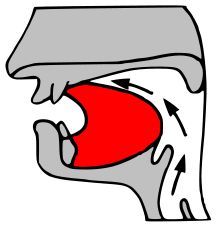Alveolarer Konsonant

| Artikulationsort |
|---|
|
| Sekundärartikulation |
Mit eme alveolare Konsonant (vùm latiinische alveolus ‚chlyne Hohlruum‘) meint mer in de Foneetik en Artikulationsort. Mer meint demit die Konsonante, wo mit de Zùng ùn em Alveolarfortsatz bildet werde. Des isch de ooberi Zaandamm, wo d Wùrzle vo de oobere Schnydzään sin.
Bi de alveolare Luut git es meereri Ùnterkategorie. Di wichtigscht Ùnterscheidig isch zwüsche alveolare Luut, wo mit de Zùngespitz bildet werde (mer sait dänne Luut „apikal“) ùn Luut, wo mit em Zùngerùgge bildet werde (däm sait mer „laminal“). In de Sprooche vo de Wält wird aber relativ sälte zwüsche apikale alveolare Luut ùn laminale alveolare Luut ùnterschide (des heisst: di meischte Sprooche hen entweder di eine oder di andre, nit beidi glychzytig). Wäge däm git es im Internationale foneetische Alfabet nùmme generelli Zeiche für alveolari Luut. Mit verschiidne Sùnderzeiche chammer de Ùnterschid einewäg kennzeichne, wänn des nöötig isch. Im Baskische git es zum Byspil ein alveolare Frikativ, wo mit de Zùngespitz bildet wird ([s̺] <s> gschriibe) ùn eine, wo mit em Zùngerùgge bildet wird ([s̻] <z> gschriibe). Die Luut sin im Baskische au verschiidni Foneem, wiemmer in Wörter wie su ‚Füür‘ ùn zu ‚du‘ gseet.
In de alemannische Dialäkt chömme siibe bis acht alveolari Luut vor, je nooch Dialäkt. Es git im Alemannische en alveolare Nasal, alveolari Plosiv, alveolari Frikativ, e stimmlosi alveolari Affrikate, ùn en alveolare laterale Approximant. In dänne Dialäkt, wommer s <r> als en Zùngespitze-r usspricht, isch au de Luut alveolar.
In de Sprooche vo de Wält chömme die alveolari Luut vor:
